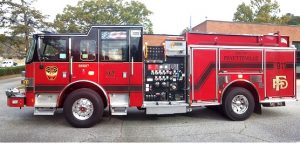It is a Thanksgiving that the Westbrook family in Fayetteville will long remember. Had it not been for the carbon monoxide detectors they installed in their home, this Thanksgiving might have been one that they never celebrated.
You can’t see it, smell it or taste it but it’s a killer. And that could have easily been the case at the home of Lee and Alice Westbrook and their 5-year-old twins Zachary and Aleya.
And while they avoided being poisoned when the natural gas furnace exhaust system began to leak, Alice and Lee are concerned that others in the community might have the same furnace exhaust piping system, one that was recalled in the late 1990s due to defects that led to having the deadly gas leak into their home.
The Westbrook family moved to Fayetteville in 2006, buying a house on the city’s southside that was built in 1994. One of the things they did was to have a central alarm and smoke detector system installed.
One of the features they added were carbon monoxide detectors. And given that the furnace was located in the crawlspace under the house, Lee installed a separate CO detector next to the furnace.
And that was that, until Lee turned on the furnace a few weeks ago when nighttime temperatures began to fall. That’s when the CO detector under the house started beeping. Lee quickly shut off the heat and kept it off during the night. The next morning he turned the heat back on and went under the house to check the detector’s batteries.
“Then the detectors inside the house began going off,” Lee said. The family evacuated the home and called Atlanta Gas Light. Once the gas was shut off, Lee contacted his home maintenance company and made contact with Elaine Powers at Powers Heating & Air.
Powers told The Citizen that the problem was with the plastic exhaust piping that was used in the early to mid-1990s to vent furnace exhaust. The piping would corrode over time and allow the exhaust containing carbon monoxide to leak.
The problems with that type of piping were identified and they were recalled during 1996-1997 due to a manufacturing defect, Powers said.
Powers said she sent letters to her customers at the time, notifying them about the problem. She said a portion of the expense of replacing the piping system was covered under the Captive Correction Program.
Today, she said, the system is completely different and the piping portion of the venting system itself is metal rather than plastic.
Powers noted that, back in the 1990s, she found that some customers had dealt with the cracking and corroding plastic piping by wrapping it in duct tape, a remedy she strongly advised against. The tape will not prevent the poisonous gas from escaping into the home environment.
And that is exactly what Lee Westbrook found at his home. It is something that many people would not think to check, but Westbrook suggested that people do check.
He found several places in the piping that ran from the furnace and across to the foundation where gray duct tape had been used to wrap the pipe. He also learned that the venting system evacuated the exhaust directly under his children’s window rather than up to the roof line.
That was something the home inspector missed before they bought the house, Westbrook said.
The Westbrook family was fortunate that Lee thought to install carbon monoxide detectors in the home. But their experience, said Alice, is a cautionary tale for everyone using natural gas to heat their homes.
“We were fortunate, but others might have this kind of piping and not realize it,” Lee said. “We were absolutely at risk. It could have killed all four of us if we had continued to be exposed.”
The reality is why Alice and Lee wanted to urge everyone with a gas furnace to make sure the venting and exhaust system is properly outfitted. The consequences, they said, are unthinkable.
After the leak was discovered Lee printed off information on carbon monoxide he found online and took it around the neighborhood, leaving it in his neighbors’ front doors.
“What we learned might save another family from what could be a catastrophe. We don’t want anyone to die,” Lee said. “Home buyers really need to inspect the inspectors. I took (the home’s safety) for granted because I paid someone to do the inspection. And I put my family at risk.”
So for Lee and Alice Westbrook and their two young children this Thanksgiving takes on more significance that ever.
Aside from the imminent danger of rapid death when inhaling larger quantities of carbon monoxide, the gas can have a number of adverse health effects when breathed in smaller quantities over time. Carbon monoxide displaces oxygen levels in the blood and can affect brain function, behavior, cognition and memory. It can also cause damage to organs of the body, including the heart.











Leave a Comment
You must be logged in to post a comment.